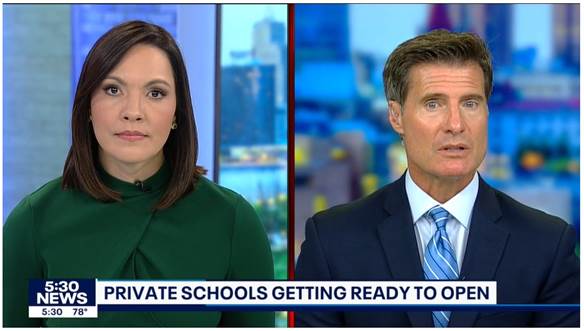It’s Teacher Appreciation Week and entitites across the state are expressing their support for those who labor day in and day out in the classroom!
Unfortunately, those words of support are often nothing more than lip service, particularly those given by our elected officials in the Minnesota Capitol. That’s because our state senators and representatives are ignoring the fact that today’s teachers want the flexibility and benefits that come from Education Savings Accounts (ESAs).
As the chart below indicates, recent polling from EdChoice shows that 70% of teachers support ESAs when they’re told what ESAs offer. This includes 84% of private school teachers and 67% of district school teachers.

You might be wondering why two-thirds of district school teachers support ESAs. The most reasonable answer is that ESAs benefit not only students, but teachers as well. Here are just a few ways Minnesota teachers stand to gain if ESAs are implemented in our state:
Fewer Top-Down Restrictions
Many of today’s district teachers have their hands tied by administrative-heavy schools or state lawmakers at the Capitol. These teachers may know what methods, curriculum, and incentives are best for the students in their classrooms, but if those are not approved by the administrative bloat at the top, then woe to the teacher who steps out of line to implement their own ideas.
ESAs, however, promise to give teachers more autonomy in the classroom. ESAs allow school funding dollars to follow the student rather than going directly to a school, which in turn spawns many alternative education models, including private, micro, charter, or home schools. As students gain the ability to branch out into these education alternatives, the need for teachers follows, giving teachers many more opportunities to find a teaching situation which welcomes their values and pedagogy. Such innovation will likely trickle into public school classrooms as well, as schools are forced to compete for the ESA money students bring with them. In essence, the more education options there are, the less teachers get put in a box by their superiors.
Expanded Work Opportunities
The aforementioned EdChoice poll found that roughly “60% of educators are interested in tutoring outside of schooling hours.” Makes sense—after all, who wouldn’t want to make a little extra dough?
Under ESAs, tutoring opportunities would likely become an even greater reality, as parents suddenly have more education funds and the ability to diversify where their children get that education. The savvy teacher can take advantage of this, potentially switching entirely to full-time tutoring, enabling the teacher to give focused attention to individual students to actually help them learn and grow.
Greater Potential for Work Flexibility
The most recent EdChoice poll found that roughly half of teachers would appreciate flexibility in their teaching schedule, having the option to teach outside the school building at least a few days a week. Again, ESAs make such a situation possible by expanding the variety of platforms through which teachers can instruct. With expanded options, some may choose to teach in online classrooms; others may choose hybrid models.
Two of these latter options were recently brought to my attention: Knox Classical Academy and Mid-Metro Academy. Both education options meet in Roseville, Minn., the former offering three-day in-person classes with two days set aside for assignments at home, while the latter offers individual classes for homeschoolers taught by teachers two days a week. The more ESAs become available, the more students and parents will look for flexible education options, and as a byproduct, teachers will gain flexibility in their teaching schedules as well.
Better Behavior
For many teachers, classroom behavioral issues are increasingly getting out of hand. EdChoice found that nearly 75% of teachers have their instruction time interrupted by discipline issues somewhat frequently, and roughly half of teachers “say that student misbehaviors are more frequent this year than last year,” particularly in district schools. Furthermore, when it comes to issues such as bullying and violent behaviors, district teachers are far less confident than their private school counterparts about their school’s ability to adequately address the issue (see chart).

As indicated above, ESAs give teachers the flexibility to move around to other schools. If they are tired of the discipline and bullying issues they’re seeing in their current public school classrooms, ESAs will pave the way for them to move to a private school, which apparently have fewer behavioral issues. Or teachers may want to start their own microschools where they can establish the behavioral standards with which they are comfortable.
Teachers know a good thing when they see it, and clearly, they’re seeing that ESAs are a win for both students AND teachers. This Teacher Appreciation Week, let’s show teachers just how much we value them by giving them the flexibility and benefits that ESAs provide.
—
Image Credit: Pexels











![[downloaded during free trial]](https://oakmn.org/wp-content/uploads/2025/11/iStock-1430368205-120x86.jpg)

